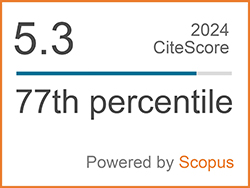Characterization of New Cellulose Fiber Extracted from Pithecellobium dulce Tree
Abstract
Keywords
[1] T. P. Sathishkumar, P. Navaneethakrishnan, S. Shankar, R. Rajasekar, and N. Rajini, “Characterization of natural fiber and composites–A review,” Journal of Reinforced Plastics and Composites, vol. 32, no. 19, 2013, doi: 10.1080/15685543.2013. 816652.
[2] T. P. Sathishkumar, P. Navaneethakrishnan, S. Shankar, and R. Rajasekar, “Characterisation of new cellulose Sansevieria ehrenbergii fibers for polymer composites,” Composite Interfaces, vol. 20, no. 8, pp. 575–593, 2013, doi:10.1080/ 15685543.2013.816652.
[3] V. P. Arthanarieswaran, A. Kumaravel, and S. S. Saravanakumar, “Characterisation of new natural cellulosic fiber from Acacia leucophloea Bark,” International Journal of Polymer Analysis and Characterization, vol. 20, pp. 367–376, 2015, doi: 10.1080/1023666X.2015.1018737.
[4] L. Bacci, S. D. Lonardo, L. Albanese, G. Mastromei, and B. Perito, “Effect of different extraction methods on fiber quality of nettle (Urtica dioica L.),” Textile Research Journal, vol. 81, no. 8, pp. 827–837, 2010, doi: 10.1177/ 0040517510391678.
[5] P. G. Baskaran, P. Senthamarainkannan, K. Marimuthu, and S. S. Saravanakumar, “Characterisation of new natural cellulosic fiber from the bark of Dichrostachys cinerea,” Journal of Natural Fibers, 15, no. 1, pp. 62–68, 2017, doi: 10.1080/ 15440478.2017.1304314.
[6] M. G. Krishna, C. Kailasanathan, and B. Nagarajaganesh, “Physico-chemical and morphological characterisation of cellulose fibers extracted from Sansevieria roxburghiana Schult. & Schult. F leaves,” Journal of Natural Fibers, vol. 19, no.9, pp. 3300–3316, 2020, doi: 10.1080/ 15440478.2020.1843102.
[7] R. Gopinath, K. Ganesan, S. S. Saravanakumar, and R. Poopathi, “Characterisation of new cellulosic fiber from the stem of Sida rhombifolia,” International Journal of Polymer Analysis and Characterization, vol. 21, no. 2, pp. 123–129, 2021, doi: 10.1080/1023666X.2016.1117712.
[8] J. Naveen, M. Jawaid, P. Amuthakkannan, and M. Chandrasekar, “Mechanical and physical properties of sisal and hybrid sisal fiberreinforced polymer composites,” Woodhead Publishing Series in Composites Science and Engineering, vol. 1, pp. 427–440, 2019, doi: 10.1016/B978-0-08-102292-4.00021-7.
[9] M. K. Pandiarajan, P. Senthamaraikannan, and S. S. Saravanakumar, “Physicochemical properties of new cellulosic Artisdita hystrix leaf fiber,” International Journal of Polymer Analysis and Characterization, vol. 21, pp. 663–668, 2006, doi: 10.1080/1023666X.2016.1194636.
[10] P. Manimaran, M. Prithiviraj, S. S. Saravanakumar, V. P. Arthanarieswaran, and P. Senthamaraikannan, “Physicochemical, tensile, and thermal characterisation of new natural cellulosic fibers from the stems of Sida cordifolia,” Journal of Natural Fibers, vol. 15, no. 6, pp. 860–869, 2017, doi: 10.1080/15440478.2017.1376301.
[11] P. Manimaran, P. Senthamaraikannan, S. M. Rangappa, M. K. K. Marichelvam, and M. Jawaid, “Study on the characterisation of Furcraea foetida new natural fiber as composite reinforcement for lightweight applications,” Carbohydrate Polymers, vol. 181, pp. 650–658, 2018, doi: 10.1016/j.carbpol.2017.11.099.
[12] P. Manimaran, S. P. Saravanan, M. Prithiviraj, “Investigation of physico chemical properties and characterization of new natural cellulosic fibers from the bark of Ficus racemosa,” Journal of Natural Fibers, vol. 18, no. 2, pp. 274–284, 2021, doi: 10.1080/15440478.2019.1621233.
[13] P. Manimaran, S. S. Saravanakumar, K. Mithun, and P. Senthamaraikannan, “Physicochemical properties of new cellulosic fibers from the bark of Acacia arabica,” International Journal of Polymer Analysis and Characterization, vol. 21, pp. 548–553, 2016, doi: 10.1080/1023666X. 2016.1177699.
[14] N. M. Pannirselvam, R. Gopinath, T. P. Sathishkumar, “Physico-mechanical, chemical composition and thermal properties of cellulose fiber from Hibiscus vitifolius plant stalk for polymer composites,” Journal of Natural Fibers, vol. 19, no. 3, pp. 1–16, 2021, doi: 10.1080/15440478.2021.1941484.
[15] M. Ramesh, M. T. Selvan, L. Rajeshkumar, C. Deepa, and A. Ahmad, “Influence of Vachellia nilotica subsp. indica tree trunk bark nano-powder on properties of milkweed plant fiber reinforced epoxy composites,” Journal of Natural Fibers, vol. 19, pp. 13776–13789, 2022, doi: 10.1080/15440478.2022.2106341.
[16] K. M. M. Rao, A. V. R. Prasad, M. N. V. R. Babu, K. M. Rao, A. V. S. S. K. S. Gupta, “Tensile properties of elephant grass fiber reinforced polyester composite,” Journal of Material Science, vol. 42, no. 9, pp. 3266–3272, 2007, doi:10.1007/s10853-006-0657-8.
[17] T. Natarajan, A. Kumaravel, and R. Palanivelu, “Extraction and characterisation of natural cellulosic fiber from Passiflora foetida stem,” International Journal of Polymer Analysis and Characterization, vol. 21, no. 6, pp. 478–485, 2016, doi:10.1080/1023666X.2016.1168636.
[18] V. Bhuvaneswari, M. Priyadharshini, C. Deepa, D. Balaji, L. Rajeshkumar, and M. Ramesh, “Deep learning for material synthesis and manufacturing systems: A review,” Materials Today: Proceedings, vol. 46, pp. 3263–3269, 2021, doi: 10.1016/j.matpr.2020.11.351
[19] K. Raja, B. Prabu, P. Ganeshan, V. S. Chandra Sekar, B. N. Ganesh, “Characterisation studies of natural cellulosic fibers extracted from shwetark stem,” Journal of Natural Fibers, vol.18, no.11, pp. 1934–1945, 2021, doi: 10.1080/15440478.2019.1710650.
[20] N. Kumar, A. Singh, K. Debnath, and N. Kumar, “Water absorption and mechanical behaviour of Borassus fruit fibre-reinforced composites,” Emerging Materials Research, vol. 9, no. 1, pp.10–17, 2019.
[21] A. S. Kumaar, A. Senthilkumar, T. Sornakumar, S. S. Saravanakumar, and V. P. Arthanariesewaran, “Physicochemical properties of new cellulosic fiber extracted from Carica papaya bark,” Journal of Natural Fibers, vol. 16, no. 2, pp. 175– 184, 2019.
[22] S. S. Kumar and V. M. Raja, “Processing and determination of mechanical properties of Prosopis juliflora bark, banana and coconut fiber reinforced hybrid bio composites for an engineering field,” Composites Science and Technology, vol. 208, Art. no. 108695, 2021.
[23] P. Senthamaraikannan, S. S. Saravanakumar, S. M. Rangappa, M. Jawaid, and S. Siengchin, “Physico-chemical and thermal properties of untreated and treated Acacia planifrons bark fibers for composite reinforcement,” Materials Letters, vol. 240, pp. 221–224, 2019.
[24] L. Rajeshkumar, M. Ramesh, V. Bhuvaneswari, D. Balaji, and C. Deepa, “Synthesis and thermomechanical properties of bioplastics and biocomposites: A systematic review,” Journal of Materials Chemistry B, 2023, doi: 10.1039/ D2TB02221D.
[25] U. V. Akhil, N. Radhika, B. Saleh, S. A. Krishna, N. Noble, and L. Rajeshkumar, “A comprehensive review on plant‐based natural fiber reinforced polymer composites: Fabrication, properties, and applications,” Polymer Composites, 2023, doi: 10.1002/pc.27274.
[26] V. Bhuvaneswari, L. Rajeshkumar, T. P. Sathishkumar, G. Rajeshkumar, S. M. Rangappa, and S. Siengchin, “Effect of fiber orientation on physical and mechanical properties of Typha angustifolia natural fiber reinforced composites,” Applied Science and Engineering Progress, vol. 16, no. 3, 2023, doi: 10.14416/j.asep.2022.11.004.
[27] M. Ramesh, L. N. Rajeshkumar, N. Srinivasan, D. V. Kumar, and D. Balaji, “Influence of filler material on properties of fiber-reinforced polymer composites: A review,” e-Polymers, vol. 22, no. 1, pp. 898–916, 2022.
[28] T. P. Sathishkumar, J. de-Prado-Gil, R. Martínez- García, L. Rajeshkumar, G. Rajeshkumar, S. M. Rangappa, S. Siengchin, A. M. Alosaimi, and M. A. Hussein, “Redeemable environmental damage by recycling of industrial discarded and virgin glass fiber mats in hybrid composites—An exploratory investigation,” Polymer Composites, vol. 44, no.1, pp. 318–329, 2023.
[29] M. Ramesh, R. Janani, C. Deepa, and L. Rajeshkumar, “Nanotechnology-enabled biosensors: A review of fundamentals, design principles, materials, and applications,” Biosensors, vol. 13, no. 1, Art. no. 40, 2022, doi: 10.3390/bios1301004.
[30] C. M. Conrad, “Determination of wax in cotton fiber, a new alcohol extraction method,” Industrial Engineering Chemistry Analytical Edition, vol. 16, no. 12, pp. 745–748, 1994, doi: 10.1021/i560136a007.
[31] J. A. Foulk, W. Y. Chao, D. E. Akin, R. B. Dodd, and P. A. Layton, “Enzyme-retted flax fiber and recycled polyethylene composites,” Journal of Polymers and Environment, vol. 12, no. 3, pp. 165–171, 2004, doi: 10.1023/B:JO OE.0000038548.73494.59.
DOI: 10.14416/j.asep.2023.05.002
Refbacks
- There are currently no refbacks.
 Applied Science and Engineering Progress
Applied Science and Engineering Progress







